
BioGeoChemistry of Tidal Flats
Modelling: Internal dynamics and forced response
The sedimentary systems in many near coastal areas are strongly coupled with the water dynamics, one illustration is the East Frisian Wadden Sea where physical impacts control coastal erosion and shoreline change through sediment movement. The major problems to be solved includes: (1) the internal variability, and (2) the response to external forcing. These are complex problems and simple conceptual models are of limited use. Therefore we base our research on results obtained from simulations with up-to-date 3D numerical model (General Estuarine Transport Model, GETM) coupled with a sediment transport model. The horizontal resolution is 200 m, the vertical resolution includes 10 sigma layers. The model setup for the East Frisian Wadden Sea (below) is explained in Stanev et al. (2003).
Our major idea is that numerical simulations provide new results and lead to further understanding of physical controls, in particular internal dynamics and forced response.
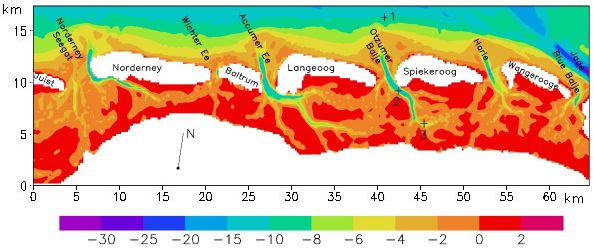 Topography of East Frisian Wadden Sea
Topography of East Frisian Wadden Sea
The isobars are represented as negative numbers (m) below the mean sea-level. The arrow giving the direction to the North demonstrates that the model area is rotated, which is done in order to reduce the size of model grid. The crests give the position where data from the model simulations have been a≠nalyzed.
Internal Dynamics
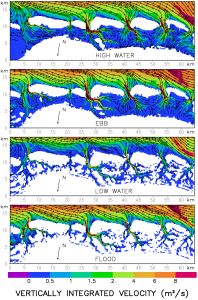 Numerical simulations demonstrate a vigorous dynamics (right) which compares well with the observations (Stanev et al., 2003). The resulting oscillatory behavior of the sediment pools north of the back-barrier basins is the key dynamic process (fig."Control Run", below-left). Although the direct exchange between individual basins is small because of the very shallow depths between them, the indirect exchange by transport and mixing of sediment pools maintains a quite active link between the basins.
Numerical simulations demonstrate a vigorous dynamics (right) which compares well with the observations (Stanev et al., 2003). The resulting oscillatory behavior of the sediment pools north of the back-barrier basins is the key dynamic process (fig."Control Run", below-left). Although the direct exchange between individual basins is small because of the very shallow depths between them, the indirect exchange by transport and mixing of sediment pools maintains a quite active link between the basins.
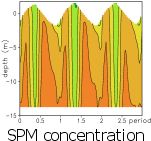 The simulations support the observed "twin-peaks" in the concentration of suspended sediment (left). The sediment model driven only by turbulent kinetic energy fails to simulate most of the characteristic temporal and spatial patterns of the suspended sediment (below-middle). The velocity gradient in the vertical exerts an important control on the sediment dynamics (below-right) and can not be neglected (as done in some simulations). By modifying the transport in the vertical plane the velocity gradient changes the relative strength of oscillations of suspended sediment concentration with tidal frequency and the ones with two times higher frequency, the latter are associated with the maxima in the turbulent kinetic energy.
The simulations support the observed "twin-peaks" in the concentration of suspended sediment (left). The sediment model driven only by turbulent kinetic energy fails to simulate most of the characteristic temporal and spatial patterns of the suspended sediment (below-middle). The velocity gradient in the vertical exerts an important control on the sediment dynamics (below-right) and can not be neglected (as done in some simulations). By modifying the transport in the vertical plane the velocity gradient changes the relative strength of oscillations of suspended sediment concentration with tidal frequency and the ones with two times higher frequency, the latter are associated with the maxima in the turbulent kinetic energy.
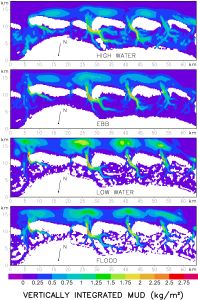 |
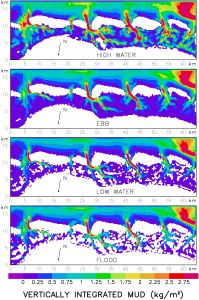 |
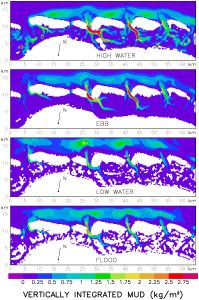 |
| Control run
|
Advection of sediment is neglected | Vertical shear of currents is neglected |
Forced response
 We address here the individual and collective contribution of tides and wind waves to the dynamics of sediment in coastal areas. The impact of wind waves is formulated using a model based on the concept that
We address here the individual and collective contribution of tides and wind waves to the dynamics of sediment in coastal areas. The impact of wind waves is formulated using a model based on the concept that 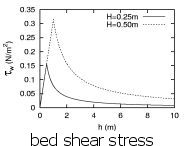 the turbulent kinetic energy associated with breaking wind waves (right) is a function of orbital velocity, the latter depends on the wave height and water depth (left). The inter-comparison between different scenarios demonstrates that the spatial patterns of erosion and deposition are very sensitive to the magnitude of wind waves.
the turbulent kinetic energy associated with breaking wind waves (right) is a function of orbital velocity, the latter depends on the wave height and water depth (left). The inter-comparison between different scenarios demonstrates that the spatial patterns of erosion and deposition are very sensitive to the magnitude of wind waves.
In all cases a net SPM flux due to wind waves is observed in the shallow area. However, depending on the height of wind waves there is an accumulation trend (for small waves) and erosion trend for large waves. For some intermediate wave lengths there is a trend of redistribution of the sediment (accumulation in the very shallow area and erosion from the deeper one). The control of the fluxes by topography gives an idea about possible feedbacks. Under wave action the erosion tends to increase the depth. Then the same waves start to propagate over deeper bottom, and deposition becomes dominating. The effects of wave breaking are more pronounced in the tidal flats where the flood maximum becomes wider and slightly waker. In such a way the effect of breaking waves ensures high enough energy for longer time, keeping thus SPM in the water column.
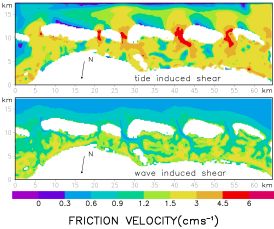 The conclusions about the role of the wind waves are not trivial. From the bed shear stress (right) one could expect a trend of erosion of shallow areas and deposition in the deep ones. Our preliminary results indicate that although this expectation is valid for most of the tidal basins the the trends of deposition minus erosion are characterized by specific spatial patterns.
The conclusions about the role of the wind waves are not trivial. From the bed shear stress (right) one could expect a trend of erosion of shallow areas and deposition in the deep ones. Our preliminary results indicate that although this expectation is valid for most of the tidal basins the the trends of deposition minus erosion are characterized by specific spatial patterns.
Relevant publications
- Stanev, E.V., Brink-Spalink, G., Wolff, J.-O., (2007), Sediment dynamics in tidally dominated environmens controlled by transport and turbulence. A case study for the East Frisian Wadden Sea. J. Geopys. Res., 112, C04018
| <<back | Publications | More details
|